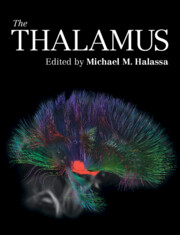Book contents
- The Thalamus
- The Thalamus
- Copyright page
- Contents
- Contributors
- Preface
- Section 1: History
- Section 2: Anatomy
- Section 3: Evolution
- Section 4: Development
- Section 5: Sensory Processing
- Section 6: Motor Control
- Section 7: Cognition
- Section 8: Arousal
- Chapter 19 The Thalamus and Sleep
- Chapter 20 Central Thalamic Contributions to Arousal Regulation
- Section 9: Computation
- Index
- References
Chapter 19 - The Thalamus and Sleep
from Section 8: - Arousal
Published online by Cambridge University Press: 12 August 2022
- The Thalamus
- The Thalamus
- Copyright page
- Contents
- Contributors
- Preface
- Section 1: History
- Section 2: Anatomy
- Section 3: Evolution
- Section 4: Development
- Section 5: Sensory Processing
- Section 6: Motor Control
- Section 7: Cognition
- Section 8: Arousal
- Chapter 19 The Thalamus and Sleep
- Chapter 20 Central Thalamic Contributions to Arousal Regulation
- Section 9: Computation
- Index
- References
Summary
The architecture of the thalamus and its reciprocal connections with multiple cortical and subcortical structures are essential to the generation of the thalamo-cortical network oscillations associated with attention, sleep, and consciousness. This chapter provides an overview of the cellular mechanisms underlying thalamo-cortical network oscillations occurring during sleep and their contribution to the architecture of the sleep–wake cycle, including the onset and stability of non–rapid eye movement (NREM) and rapid eye movement (REM) sleep. It further summarizes the influence of the brainstem neuromodulatory system on thalamo-cortical network activity during wakefulness and sleep. Finally, the association between these mechanisms and synaptic plasticity in thalamo-cortical networks is described in the context of sleep-dependent consolidation, or weakening, of previously acquired information in health and disease.
- Type
- Chapter
- Information
- The Thalamus , pp. 361 - 381Publisher: Cambridge University PressPrint publication year: 2022



